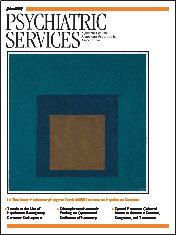High Utilizers of Psychiatric Emergency Services
Abstract
OBJECTIVE: The purpose of this study was to examine the sociodemographic and clinical characteristics of high utilizers of psychiatric emergency services. METHODS: Data were collected over four years for 761 patients who were identified as high utilizers according to three definitions (two standard deviations above the mean number of visits to an urban psychiatric emergency service, six visits in a year, and four visits in a quarter) and for 1,585 nonfrequent utilizers (control group). Univariate analysis of variance and logistic regression models were used to determine group differences. RESULTS: Two distinct groups of high utilizers emerged: high utilizers by quarter and high utilizers by standard deviation. Compared with the control group, the high utilizers were more likely to be homeless, to have developmental delays, to be enrolled in a mental health plan, to have a history of voluntary and involuntary hospitalizations, to be uncooperative, to have personality disorders, to have unreliable social support, and to have a lifetime history of incarceration and detoxification. Compared with the high utilizers by quarter, the high utilizers by standard deviation had more visits and were more likely to have a history of incarceration and psychiatric hospitalization, more likely to be enrolled in mental health plan, and less likely to be homeless. CONCLUSIONS: High utilizers make up a small percentage of individuals who seek care in psychiatric emergency services and disproportionately use resources. It may be helpful to use two definitions of high utilizer to identify patients at different phases of their illness and to guide clinical interventions and mental health policies.



